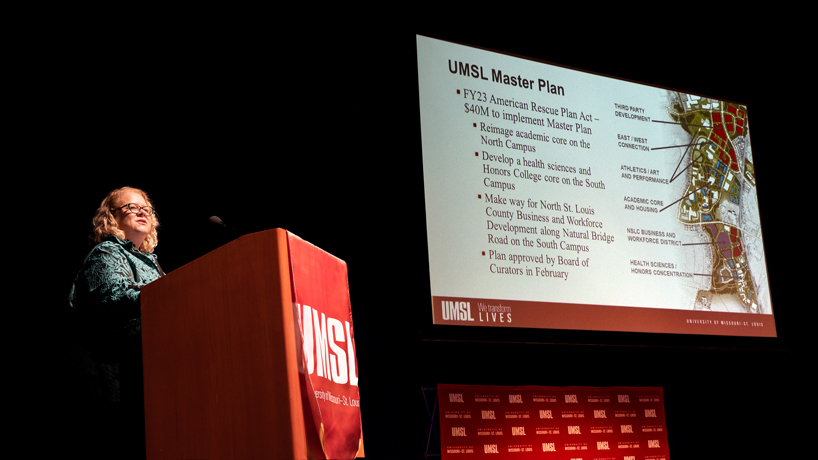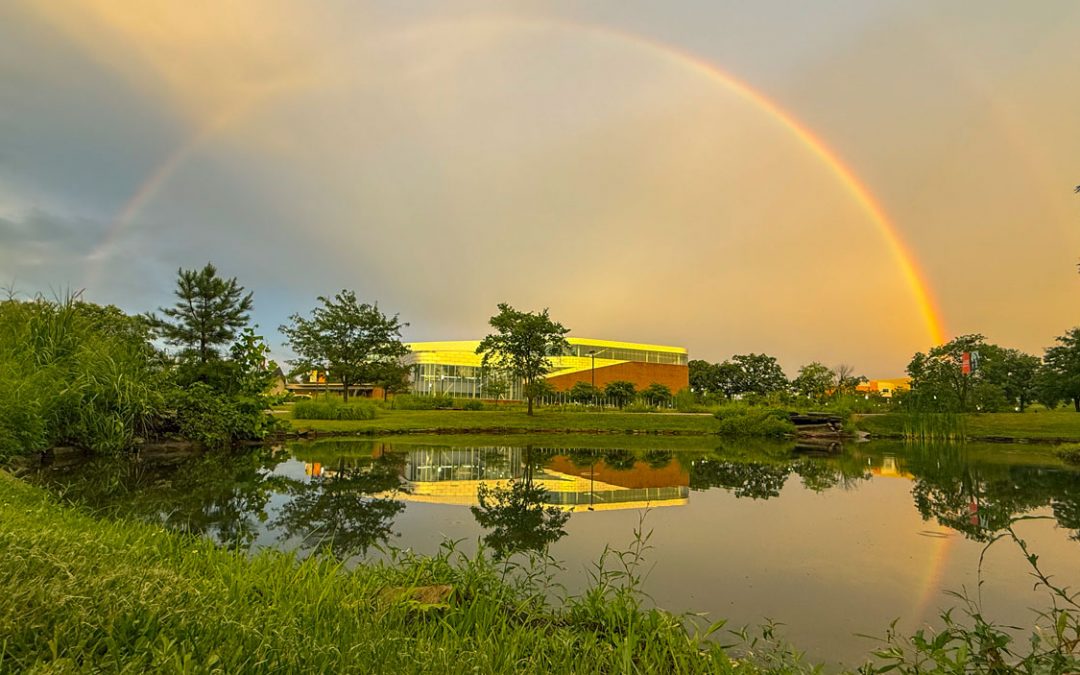
Chancellor Kristin Sobolik describes how funding from the American Rescue Plan is helping UMSL implement its master plan during the annual State of the University Address on Thursday afternoon at the Blanche M. Touhill Performing Arts Center. (Photo by August Jennewein)
The University of Missouri–St. Louis is taking the first steps toward a historic transformation of its campus as the university moves into its 60th year.
Chancellor Kristin Sobolik used her annual State of the University Address to share the vision for the changes to come over the next four years as UMSL consolidates its academic core, revitalizes its library and begins construction of the Richter Family Welcome and Alumni Center, among other projects.
“This consolidation will build a more cohesive academic experience while connecting campus assets and creating a collaborative environment for learning, research and innovation,” Sobolik told the audience Thursday afternoon in the Anheuser-Busch Performance Hall at the Blanche M. Touhill Performing Arts Center.
Consolidating the academic core will involve a comprehensive renovation of classroom, laboratory and community spaces as the College of Education prepares to move from South Campus to the Social Sciences Building on North Campus and the College of Optometry moves much of its operations into the second floor of the Patient Care Center. The Departments of Music and Art and Design will also be moving into the renovated Arts Administration Building.
These updated spaces— along with changes coming to the Thomas Jefferson Library, including a new entryway facing the Quad on the north side of the building, new lab and study spaces and a café – will better serve the needs of students in the years ahead.
Sobolik noted that the subsequent demolition of vacant buildings, including Marillac Hall and the Music Building, will allow the university to clear 35 acres of land on South Campus for development of the North St. Louis County Business and Workforce District, which will help spur economic growth and provide community assets along the Natural Bridge corridor.
The planned changes are supported by an unprecedented $40 million appropriation from the state of Missouri through the American Rescue Plan Act.
“UMSL is grateful for the support of Governor Mike Parson, who included our funding request in his 2023 Fiscal Year Budget,” Sobolik said. “We also extend our thanks to the Missouri Legislature, including the St. Louis delegation, led by 14th District Sen. Brian Williams. This extraordinary show of legislative support for our campus is critical to the implementation of the UMSL Master Plan.”
UMSL also has a request in front of the St. Louis County Council to provide an additional $20 million in county-directed ARPA funding to meet the matching requirements of the state.
Members of the campus community can keep up to date with the progress of the many multi-year projects on the university’s Transform UMSL website.
Other highlights from Sobolik’s presentation:
- UMSL has seen a 67% increase in full-time first-time college students and realized an 18% increase in full-time transfer students this year while welcoming more than 130 international students from 28 different countries. Enrollment challenges remain, but the university is working to support growth through an increased focus on workforce integration, including strategic partnerships with Amazon and Generation USA/Verizon.
- The university continues to develop new courses and degree programs to meet business and workforce needs. It recently launched a joint online BA in Psychology with the University of Missouri–Columbia, and it also received approval from the Missouri Department of Higher Education and Workforce Development to begin offering an MS in Financial Technology beginning in the spring semester. It’s also added new certificate programs, including graduate certificates in analytical chemistry, personal finance for educators and career counseling.
- Despite continued challenges caused by the COVID-19 pandemic, UMSL closed the last fiscal year with a balanced budget and delivered on its commitment to provide merit raises to employees.
- Philanthropic giving increased by 45% to $29 million in FY22. More than $2 million of those gifts went to establish 27 named scholarships, and UMSL now has 548 endowed scholarships.
- More than 200 people stepped forward to help UMSL students, faculty and staff members impacted by the recent flooding by donating to the Triton Emergency Fund. In all, UMSL raised more than $70,000 to help members of the campus community start to recover.
- UMSL has seen a dramatic increase in the level of external research awards – up 11% to nearly $36 million in the past year. Research expenditures also grew by 24% percent to $33 million, and expenditures have now risen by 65% over the past five years.
- The university is working to expand its research profile. UMSL and Saint Louis University are co-leading research and development for the St. Louis Regional Advanced Manufacturing Innovation Center. It has also established a Collaborative Research and Development Agreement with the National Geospatial-Intelligence Agency that will create opportunities for UMSL researchers to work with the agency on geospatial research, training and other initiatives aimed at innovation. A new partnership with Cortex and Active Pharmaceutical Ingredients will help enable the delivery of a market-competitive commercial supply of US-made APIs.
- UMSL and Edward Jones are co-leading the St. Louis Anchor Action Network, which brings together institutions, businesses, community leaders and other stakeholders to address longstanding racial, economic and spatial inequities in the St. Louis region. Network members are committing to increase employment and purchasing by 10% in a footprint that includes 22 ZIP codes centered in north St. Louis County and the City of St. Louis. The university has already exceeded that goal, increasing its number of employees from the footprint by 30%.
- The Department of Athletics had arguably the most successful year in school history with the men’s and women’s basketball teams and volleyball team all qualifying for the NCAA Tournament, 10 swimmers qualifying for the NCAA Championship, and the men’s and women’s golf team advancing to the NCAA Championships. Senior golfer Joel Sylven capped off the year by claiming the second national title in school history. UMSL also had a record 158 student-athletes receive Academic All-GLVC honors.
Watch the address:














